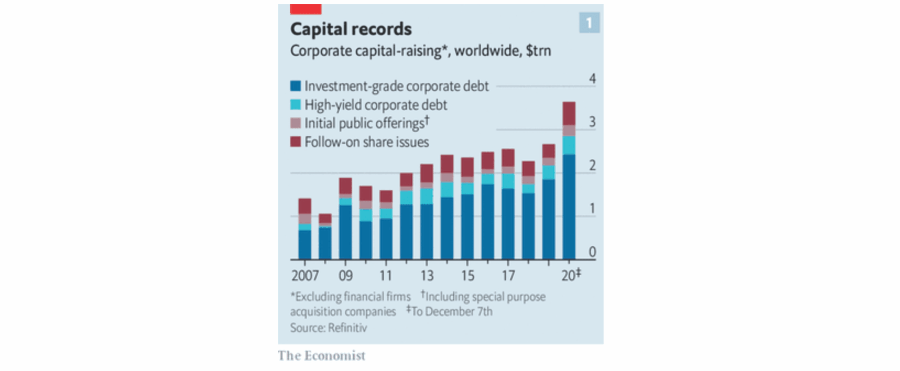by David Robertson, CFA, CEO, Areté Asset Management
The “Bonfire Of Money” and the distortion of capital and markets.
Coming to the end of a great year, investors ponder how much longer the stock market can rally. Abundant liquidity and low-interest rates have almost forced investors into risk assets. The big question is, “How much longer can this go on?”
Part of the answer may lie in a shift that occurred in capital markets during the year. For many years, the market’s characterization for equity capital was massive share repurchases, mostly funded with debt. However, the tide turned this year as companies cranked up the issuance of new shares and dialed down repurchases. This change in net equity issuance has important implications for investors.
Capital Raising Records
An exciting and essential part of the story of returns in capital markets for the year was the rapid reversal of sentiment in March. After the Fed and Government launched a massive monetary and fiscal policy response to stanch the crisis, investors immediately flipped from “fear” to “greed.”
Shortly after that happened, another interesting phenomenon occurred. Companies began issuing new capital at a record-breaking pace. The Economist reports on the veritable feeding frenzy that ensued:
“According to Refinitiv, a data provider, this year the world’s non-financial firms have raised an eye-popping $3.6trn in capital from public investors (see chart 1). Issuance of both investment-grade and riskier junk bonds set records, of $2.4trn and $426bn, respectively. So did the $538bn in secondary stock sales by listed stalwarts, which leapt by 70% from last year, reversing a recent trend to buy back shares rather than issue new ones.“
A new wrinkle in the wave of capital raising was the increasing prominence of equity. Not only did secondary sales shoot up, but the IPO market also sprung wide open:
“Initial public offerings (ipos), too, are flirting with all-time highs, as startups hope to cash in on rich valuations lest stockmarkets lose their frothiness, and venture capitalists (vcs) patience with loss-making business models.”
Part of the zeal to raise debt was low rates and partly due to the Fed’s backstop of corporate credit. These factors provide ample rationale for the increase in debt issuance.
The Cost Of Equity Capital
The case for raising equity is a bit different, though. For one, there is no backstop for stocks, at least not at this time. There is no actual, explicit number that investors can refer to as a cost of equity capital like there is an interest rate for the cost of debt.
Of course, there are various analytical formulas for determining the cost of equity capital, but most are backward-looking and therefore provide only general approximations.
Because the cost of equity capital has more significant ambiguity, any additional insight into this vital metric can be useful. To this point, company actions reveal helpful information content. When a company issues new stock, its management team judges that the cost of equity capital is attractive.
Two Sides Of A Coin
The cost of capital for a company is the same as an investor’s expected return. If a company has a low cost of capital, it also has low expected returns.
Valuations are another way of looking at the same thing. A high valuation implies a low expected return, which means a low cost of capital. Some recent estimates of expected returns confirm that the equity cost of capital is currently attractive.
For example, GMO’s latest forecast presents expected annual returns of -5.8% for large-cap US stocks and -7.1% for small caps. Similarly, John Hussman’s latest forecast calls for expected returns of -3.6% for the S&P 500.
The negative expected returns imply that the cost of equity capital is currently better than attractive for companies. It means investors are paying companies for the privilege of giving them capital. As such, it is no surprise that companies are taking them up on the offer by increasing the supply of equity capital.
Reality Checks
If this conclusion seems stretched, the supply and demand of economics is a corroborative reality check. All else equal, if you increase the supply relative to demand, the price goes down. As such, when the supply of capital goes up, its price comes down.
It is possible to argue that all else is not equal. After all, growth opportunities are emerging from the disruption of the pandemic that arguably is best served by equity capital. While this is true in some instances, it is much less compelling in aggregate. The bigger picture shows the economy is still operating at a lower level than when the pandemic struck.
Another piece of evidence for the excessive supply of equity capital is the IPO market. While there is always some sense of opportunism with IPOs because they create liquid currency for founders, a new and different type of opportunism seems to be emerging this time around.
Byrne Hobart describes in his newsletter “The Diff,” how Roblox and Affirm have delayed their IPOs because they “are both worried that the market is too good.” Hobart hypothesizes that the strategy is something like, “wait a while, figure out what else they can spend on, and then sell significantly more stock at a higher valuation than planned.” In other words, they’ll have to do some serious thinking about how to spend all of the money they can raise in such a benign environment. Such is not an indicator that capital is scarce.
Card Sharks Or Suckers?
The emergence of significant equity capital issuance facilitates an interesting perspective on the market. One line of thinking advocates investors should have more aggressive participation. It applies the poker analogy of “playing the player” and recognizes the Fed (and other central banks) will not let the markets fall for any length of time. As a result, investors should buy dips and apply leverage liberally. After all, how else can you earn returns?
Another line of thinking, however, recognizes this view as incomplete. Yes, the Fed (and other central banks) are players in the game, but corporate CFOs have also joined the game. Further, those CFOs also happen to know their businesses better than anyone else and are privy to material nonpublic information.
This development radically changes the competitive dynamics. Before, aggressive investors were competing against less aggressive investors for return/risk opportunities. Such investors could fancy themselves cleaning up at the poker table at the expense of overly timid investors.
Now, aggressive investors are also competing against well-informed corporate CFOs. As these new players have entered the game, aggressive investors look more like unsuspecting suckers at the poker table.
Pandemic Policy Parallel
The continued runup in stocks amid substantial increases in new stock issuance has an interesting parallel to one of the pandemics related policy measures. Specifically, PPP loans were designed to assist small businesses in the US, and “bounce back” loans served a similar purpose in the UK. In both cases, there were significant flaws. The FT highlights problems in the UK:
“Launched by chancellor Rishi Sunak in May, it [the bounce back loan program] was designed to provide cash quickly for struggling businesses, but its loose rules were immediately exposed with some estimates suggesting as much as £26bn [of £43.5bn total] will be lost to defaults and fraud.”
The widespread evidence of fraud and misappropriation of funds compelled the FT to headline the story as “A giant bonfire of taxpayers’ money.” The situation is essentially the same in equity markets. With money being thrown around with little scrutiny or oversight, it is fair to expect a similar result – there will be significant losses.
The Economist arrives at a similar conclusion, albeit in more modest terms:
“In a world of near-zero interest rates, it appears, investors will bankroll just about anyone with a shot at outliving covid-19. Some of that money will go up in smoke, with or without the corona-crisis.“
Conclusion
To a significant extent, you can forgive investors for wondering how much longer the rally in stocks can continue. With low rates and ample liquidity, there are little holding stock prices back. There is just no way to know when the rally will end.
What is much less forgivable is overlooking how capital markets have changed through the course of the year. Namely, the increasing issuance of stock sends an important signal to investors. Such suggests an upper limit to where stocks can go because companies will continue to issue new stock at desirable rates until those rates become less attractive. Increasingly, the benefits of the current environment will accrue to corporations at the expense of outside investors. Keeping this in mind will go a long way in preventing your giant bonfire of money.
David Robertson CFA is the CEO of Areté Asset Management and founded Areté with the mission of helping people to get the most out of their investing activities. Most of his career has focused on researching stocks and markets, valuing securities, and managing portfolios for mutual funds, institutional accounts, and individuals. He has a BA in math from Grinnell College and a Masters of Management from the Kellogg School of Management at Northwestern University. Follow Dave on LinkedIn and Twitter.














